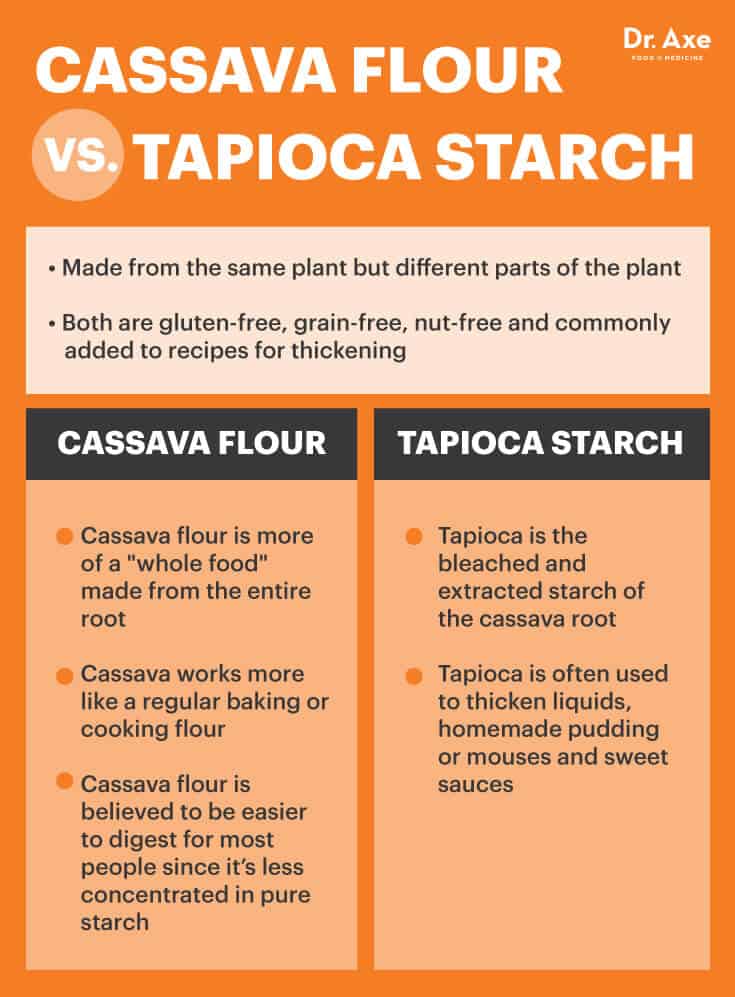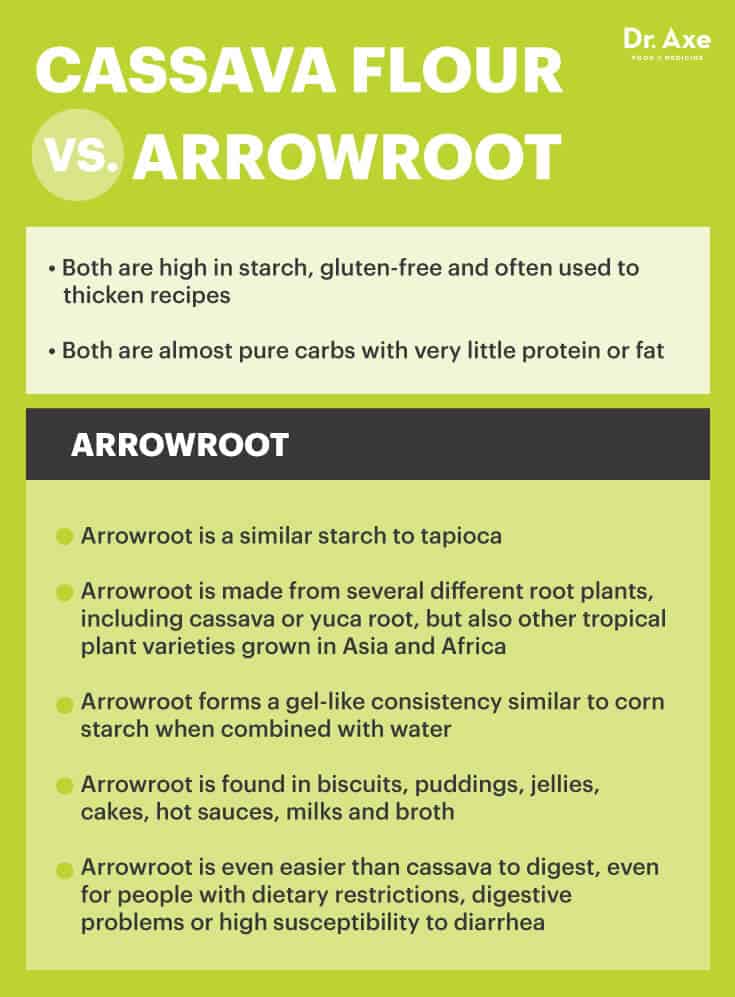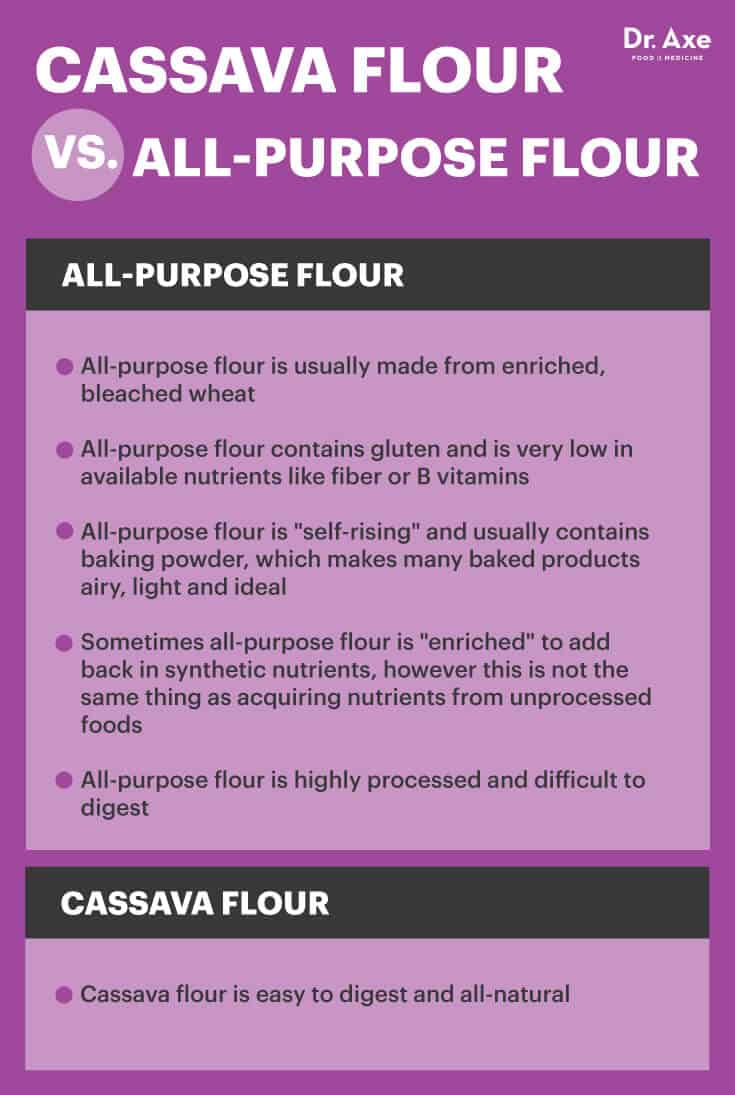Exploring Cassava Flour
Cassava Flour
Thinking of giving up gluten? Cassava flour just may be what you’re looking for to help.
What is cassava flour? It’s a type of wheat-free, gluten-free flour alternative that’s made by grating and drying the fibrous cassava root (yuca). Otto’s Naturals, one of the leading suppliers of cassava flour, calls this product the “next generation in grain-free baking” due to its easy-to-use texture and mild taste.
You also might have hard of another popular product made from cassava: tapioca. Tapioca is usually found in stores in the form of small, white pearls made from extracted cassava starch. (1)
So what makes this gluten-free flour so great? Check out the top four benefits of cassava flour below, along with how to use it, how it stacks up against other flours and how to make your own.

What Is Cassava?
Cassava (Manihot esculenta Crantz) is a type of plant that produces a starchy root crop (often called yuca or yuca root), which is one of the most valuable sources of nutrition for more than 500 million people living in Africa, Asia and Latin America. (2) Compared to many other crops, cassava requires a low amount of energy to produce and yields a high amount of edible crop per plant, making it one of the world’s most valuable stable crops.
Nearly every part of the cassava plant can be used in some way. Cassava plants are highly intolerant to stressful environments and can be grown in regions of the world where fresh food is commonly scarce, which is why its considered a sustainable and important security crop for preventing famine. (3)
Other than the starchy roots of cassava shrubs, the leaves and stems of cassava can also be used to make food for both humans and animals. Some of the ways that cassava is traditionally used around the world include making soups, stews and even livestock feed out of cassava leaves. The stems are also replanted to help increase mushroom growing, used to make firewood for heating and made into various paper products.
Health Benefits
1. Can Be Used in Place of Wheat Flour
Cassava flour is easy to use in recipes in place of traditional grain-based flours or even gluten-free flour blends. One of the best things about using cassava flour is its neutrality in terms of taste. It doesn’t have a dry, strong or unfamiliar taste or texture that often comes with using some gluten-free flours.
Many people find that cassava can be used in recipes without it even being detected at all and that it’s practically indistinguishable from wheat-based counterparts. Its texture lends well to baking things like brownies, cookies and denser breads, or you can use it in savory dishes to thicken sauces or to form burgers/patties.
Many people like baking with cassava flour since it doesn’t have a sour taste or smell that fermented, sprouted grain flours sometimes can carry. If you’re going to bake something like bread or cake and require a flour that rises well, cassava can be used to replace a portion of the flour in the mixture. For recipes that don’t require rising, cassava can totally replace grain flours.
2. Non-Allergenic (Gluten-Free, Grain-Free and Nut-Free)
If you’re unable to use coconut or nut-based flours in recipes (like almond flour), cassava is another great alternative for gluten-free baking. Some manufacturers even sell high-quality cassava flour that’s gluten-free certified by the the Gluten Intolerance Group.
Because it’s totally grain-free, cassava flour is a good choice for more than just those with gluten intolerance symptoms — it’s also paleo-friendly and can also be consumed by people with sensitive digestive systems or disorders, such as irritable bowel disease or irritable bowel disease.
In fact, it’s a popular flour alternative for those following an autoimmune protocol diet like the GAPS Diet Plan and Protocol due to its high digestibility.

3. Low In Calories, Fat and Sugar
Cassava has less than 120 calories for a quarter-cup serving, making it lower in calories than some other gluten-free flours, such as almond or coconut flour. Overall, it has a higher water content, lower fat content and lower calorie density than other flours, including corn, wheat, plantain, almond, coconut, rice and sorghum flour.
Cassava flour makes a good choice for people with health conditions like diabetes, high blood pressure or high cholesterol, since it’s extremely low in salt/sodium, sugar and fat, plus totally free from refined carbohydrates and synthetic ingredients. Depending on what other ingredients you use cassava with, it can help you maintain normal blood sugar and provide a good source of energy.
Cassava flour is high in carbs and provides a similar amount of carbohydrates as most other grain-based flours, which can be helpful for supporting energy levels in people who are active but avoid eating other starches. In fact, because it’s so high in carbohydrates, experts estimate that cassava plants provide the third-highest yield of carbohydrates per person in many parts of the world (after sugarcane and sugar beets).
Its composition is about 60 percent to 65 percent water moisture, 20 percent to 31 percent carbohydrates, and less than 2 percent protein and fat. In some parts of Africa, it provides up to 30 percent of total daily calories!
The best way to use cassava flour is probably to pair it with other nutrient-dense, complimentary foods in order to boost the fiber, vitamin and mineral content of recipes.
For example, you can increase the amount of fiber in recipes by using cassava flour in combination with high-fiber foods like chia seeds or flaxseeds. It can also be used to make pizza dough or crepes that you can top with your favorite healthy ingredients, such as raw cheese, tomato sauce, veggies, fruit or avocado.
4. Inexpensive, Sustainable and Easy to Grow
Cassava plants are grown in over 90 countries worldwide and are able to withstand less-than-optimal environmental growing conditions, making them highly sustainable according to research done at the International Center for Tropical Agriculture in Colombia. Cassava has been found to assimilate carbon at very high rates under high levels of humidity, withstand high temperatures and solar radiation, and survive in environments whether dry or humid.
Due to characteristics like having a “fine root system, long leaf life, strong root sink and high leaf photosynthesis,” cassava helps feed millions of people every year who are susceptible to famine and living in stressful environments. The shrubs have been found to survive even in very poor soils and under prolonged drought conditions, which helps cassava growers reduce their use of water while still producing a high crop yield.
Purchasing cassava flour and other cassava products also helps support growers who rely on exporting cassava to earn an income, provide employment opportunities and serve as a reserve food in times of scarcity. (5)
Nutrition Facts
A quarter-cup serving of cassava flour has about:
- 114 calories
- 2 grams of fiber
- less than 1 gram of fat, protein or sugar
- 28 grams of carbohydrates
- about 17 percent of daily vitamin C
In addition, one cup of raw cassava contains about: (6)
- 330 calories
- 78.4 grams carbohydrates
- 2.8 grams protein
- 0.6 gram fat
- 3.7 grams fiber
- 42.4 milligrams vitamin C (71 percent DV)
- 0.8 milligram manganese (40 percent DV)
- 558 milligrams potassium (16 percent DV)
- 55.6 micrograms folate (14 percent DV)
- 0.2 milligram thiamine (12 percent DV)
- 43.3 milligrams magnesium (11 percent DV)
- 0.2 milligram copper (10 percent DV)
- 1.8 milligrams niacin (9 percent DV)
- 0.2 milligram vitamin B6 (9 percent DV)
- 0.1 milligram riboflavin (6 percent DV)
- 55.6 milligrams phosphorus (6 percent DV)
- 3.9 micrograms vitamin K (5 percent DV)
- 0.7 milligram zinc (5 percent DV)
Although it’s not very high in fiber, protein, healthy fats or other essential nutrients (aside from vitamin C), cassava is low in calories and allows you to enjoy some of your favorites recipes without the use of processed, bleached or gluten-containing flours.
Cassava is a good source of vitamin C — an important antioxidant tied to cancer prevention, eye health and skin health— although it’s debatable how much vitamin C is retained during cassava’s manufacturing process. All things considered, however, cassava is exceptionally high in vitamin C compared to many other staple crops (and grains) and a better vitamin C source than potatoes, yams, wheat brown rice, corn and plantains. (7)
Why use cassava flour instead of other gluten-free flours? It has a fine texture, neutral taste, white color and low fat content compared to almond flour or coconut flour. It’s also suitable for people with allergies who can’t consume nuts or coconut and is completely gluten- and grain-free. Many people describe the taste of cassava as being similar to that of white potatoes, except the texture is a bit more smooth and “buttery.”

Cassava Flour vs. Other Flours/Starches
Cassava Flour vs. Tapioca Starch
Cassava flour and tapioca flour (also sometimes called tapioca starch) are both made from the same plant — however, they’re from different parts of the plant. The cassava plant itself is brown with rough skin, while the inside is softer and a yellow-white color. Tapioca is the bleached and extracted starch of the cassava root, while cassava flour is more of a “whole food” made from the entire root. Extraction is usually not needed to make cassava flour since it’s naturally grown, peeled, dried and then milled.
Both products are gluten-free, grain-free, nut-free and commonly added to recipes for thickening. Tapioca is often used to thicken liquids, homemade pudding or mouses, and sweet sauces, while cassava works more like a regular baking or cooking flour. It’s believed that cassava flour is also easier to digest for most people since it’s less concentrated in pure starch.
Cassava Flour vs. Arrowroot
Arrowroot is another starchy food product that’s similar to tapioca. It’s made from several different root plants, including cassava or yuca root, but also other tropical plant varieties grown in Asia and Africa. Like tapioca and cassava flour, it’s high in starch, gluten-free and often used to thicken recipes.
When combined with water, it forms a gel-like consistency similar to corn starch, making it a popular ingredient for baking. Around the world, arrowroot is found in biscuits, puddings, jellies, cakes, hot sauces, milks and broth. It’s considered easy to digest, even for people with dietary restrictions, digestive problems or high susceptibility to diarrhea. Like tapioca and cassava flour, arrowroot is almost pure carbohydrates, with very little protein or fat.
Cassava Flour vs. All-Purpose Flour
All-purpose flour is usually made from enriched, bleached wheat. It’s “self-rising” and usually contains baking powder, which makes many baked products airy, light and ideal. However, it also contains gluten and is very low in available nutrients like fiber or B vitamins, since these are removed during the manufacturing process.
Sometimes all-purpose flour is “enriched” to add back in synthetic nutrients, but this is not the same thing as acquiring nutrients from unprocessed foods! The biggest reason to avoid all-purpose flour is because of how highly processed and difficult to digest it is. It’s one of the leading sources of gluten in many people’s diets, which is a common allergen and inflammatory protein that’s often linked to gut troubles and digestive issues, such as leaky gut syndrome.

How to Use in Recipes
Although it won’t provide ideal results when used in all recipes, cassava flour can be used as a 1:1 substitute in countless recipes for other flours, including wheat flour and all-purpose flour. Keep in mind that cassava must be cooked properly to detoxify it before it’s eaten, so never consume it raw. Around the world, it’s used in many ways, including as a addition to sweet desserts, replacement for potatoes, or ground and cooked to a form a dry meal known as farofa (used as a condiment, toasted in butter or eaten on its own).
Always look for products labeled “100 percent Yuca (Cassava)” that ideally only have one ingredient and no fillers or preservatives.
Some of the ways you might want to use cassava flour include adding it to recipes for:
- gluten-free cassava bread
- cakes
- cookies
- brownies
- pancakes
- pizza crust or dough
- crepes
- burgers
- sauces or gravy
- tempura batter
In most cases, cassava works well when you use it in the same proportion as wheat flour — however, there are some cases when other flours would be a better choice. In yeast-based recipes (like most types of bread, for example), a direct substitution of wheat flour for cassava likely won’t work well, since cassava won’t naturally rise and produce a fluffy outcome like yeast and wheat (which contains gluten). If you don’t mind a denser finished product, you can still make bread with cassava flour, but most people prefer using it in recipes that don’t need to rise.
Here are a few tips when working with cassava flour:
- Before using cassava flour, give it a good whisk to remove lumps.
- Try different combinations of flours to see which results you like best, mixing cassava with other gluten-free flours like rice, oat or coconut flour.
- If you replace other flours with cassava and feel that the finished product lacks moisture and feels too gritty, try using about 15 percent to 20 percent less cassava next time.
- Some suppliers of cassava flour purposefully use only young, tender yuca roots instead of more mature roots in order to cut down on the amount of fiber and grit in the flour, so look for these varieties if you aren’t initially happy with the results.
Recipe
The highest-quality cassava flour is the kind made within just one or two days of harvesting the root. Some cassava flours sit on store shelves for much longer than this, so it’s a good idea to purchase from a reputable seller whenever possible if making your own isn’t something you’re up for.
If you’d like to use the freshest possible cassava flour, you can prepare your own at home pretty easily and for a very low cost. You need to purchase cassava roots from a supplier and have on hand kitchen requirements, including a grater, food processor, mortar or meat pounder, and a drying rack. It’s also possible to buy cassava seeds or plants and grow your very own roots in your backyard.
Follow these steps in order to make your own high-quality cassava flour:
1. Purchase your roots: Look online to buy mature, freshly harvested cassava roots. If you’re able to find them in stores, look for roots that are firm without any bruising or cracks.
2. Peel and wash the roots: Remove the stalk and woody tips from the roots. Peel the root with a hand-held peeler just like you would potatoes or carrots, then rinse them well. Peeling the root is also recommended since the peels naturally contain a very small amount of cyanide. However, it’s not a high enough amount to usually cause a problem and is nearly always thoroughly removed during manufacturing and heating.
3. Grate the roots: Grate cassava roots into a fine mash, using a hand-held grater or food processor.
4. Press and dry the roots: Pack the grated cassava mash into a clean bag or cheesecloth sack to press its water out. Get the cassava mash as dry as possible, then spread it onto a drying rack. Ideally, you can place the rack in the sun outside, or you can slowly dry the flour in a dehydrator or your oven at a low temperature. If you find that drying outdoors in the sun makes the cassava starch ferment and take on a sour, musty smell and taste, then use your oven instead. If you don’t have access to sunshine (it’s raining or you live in an apartment), this is a good time to dry cassava indoors too.
5. Mill and sift your flour: The dried cassava mash is ready when it produces a crumbly, white-colored flour. Gently mill/mash the flour into a fine texture with a mortar and sift through it to remove any clumps or leftover fibrous materials. Once it’s ready, you can use cassava flour in recipes right away or store it somewhere cool and dry for several months. Ideally use it within about three months to up to six months.
Final Thoughts
- Cassava flour is a gluten-free, wheat flour alternative that’s made by grating and drying the fibrous cassava root (yuca) and non-allergenic.
- It’s gluten-free, grain-free and nut-free; low in calories, fat and sugar; and inexpensive, sustainable and easy to grow.
- You can make your own cassava flour in five simple steps: Purchase the roots, peel and wash the roots, grate the roots, press and dry the roots, and mill and sift your flour.





Leave a comment